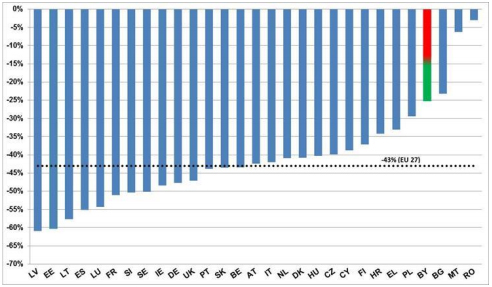
The objective of the present paper is to explore key parameters contributing to road safety in Belarus through the analysis of basic road safety data. In addition, road safety trends in Belarus are compared to those of EU member countries, which based on the different socio-economic and road safety characteristicsare categorized in three distinct groups, , namely; North-west, South and East EU members. On this purpose the latest general trends in road safety in Belarus were recorded and socio-economic parameters were selected to explore the impact of each one of them to the number of road fatalities per population. A lognormal model was developed for Belarus and for the selected groups of EU countries. Dimensionless elasticities were used for the direct comparison of all model parameters, in order to identify differences and similarities in road safety performance in the examinedcountries. The examination of Belarus revealed findings very similar to those of East EU member countries, according to which the number of road fatalities per population was found to be affected by the GDP per capita but not by the total fleet. Specifically, an increase in the GDP per capita leads to a decrease in road fatalities per population. A negative relation between GDP per capita and road fatalities per population, although morethan double in terms of quantitative impact, was also found in the case of Northwest EU members.Contrary to the above findings, regarding South EU countries, the analysis showed that the total fleet has an impact on the number of road fatalities per population, where the GDP per capita has the adverse kind of impact on road fatalities per population than in the other examined groups. The results of this research revealed the importance of basic socio-economic parameters on road fatalities’ macroscopic trends. Common characteristics of neighbouring countries may explain similar road safety performance, and relevant findings may be exploited by all those who attempt to identify future road safety trends and propose appropriate countermeasures and policies.
| ID | pc225 |
| Presentation | |
| Full Text | |
| Tags | accident analysis, information systems, international comparisons |






